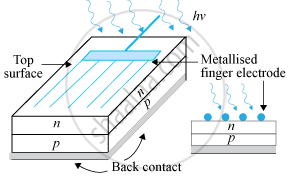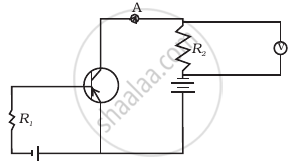Advertisements
Advertisements
प्रश्न
Answer the following question.
Explain the three processes involved in solar cell working.
उत्तर

The generation of emf by a solar cell, when light falls on, it is due to the following three basic processes: generation, separation and collection
- generation of e-h pairs due to light (with hν > Eg) close to the junction
- separation of electrons and holes due to electric field of the depletion region. Electrons are swept to n-side and holes to p-side
- the electrons reaching the n-side are collected by the front contact and holes reaching the p-side are collected by the back contact. Thus the p-side becomes positive and the n-side becomes negative giving rise to photo-voltage.
APPEARS IN
संबंधित प्रश्न
With what considerations in view, a photodiode is fabricated? State its working with the help of a suitable diagram.
Even though the current in the forward bias is known to be more than in the reverse bias, yet the photodiode works in reverse bias. What is the reason?
A p-n photodiode is fabricated from a semiconductor with band gap of 2.8 eV. Can it detect a wavelength of 6000 nm?
The width of depletion region of p-n junction diode is _______.
(A) 0.5 nm to 1 nm
(B) 5 nm to 10 nm
(C) 50 nm to 500 nm
(D) 500 nm to 1000 nm
Write briefly the important processes that occur during the formation of p−n junction. With the help of necessary diagrams, explain the term 'barrier potential'.
Describe briefly, with the help of a diagram, the role of the two important processes involved in the formation of a p-n junction ?
How does a light emitting diode (LED) work? Give two advantages of LED’s over the conventional incandescent lamps.
Name the device which converts the change in intensity of illumination to change in electric current flowing through it. Plot I-V characteristics of this device for different intensities. State any two applications of this device.
The amplifiers X, Y and Z are connected in series. If the voltage gains of X, Y and Z are 10, 20 and 30, respectively and the input signal is 1 mV peak value, then what is the output signal voltage (peak value)
- if dc supply voltage is 10V?
- if dc supply voltage is 5V?
If the resistance R1 is increased (Figure), how will the readings of the ammeter and voltmeter change?

Draw the circuit diagram of an illuminated photodiode and its I-V characteristics.
